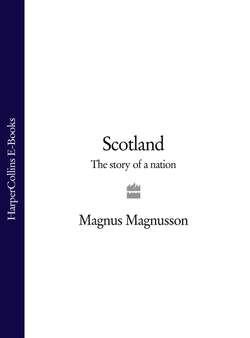Читать книгу Scotland: The Story of a Nation - Magnus Magnusson - Страница 40
Chapter 6 DAVID I (r.1124–53)
ОглавлениеDavid was a most excellent sovereign … He founded bishoprics, and built and endowed many monasteries, which he vested with large grants of lands out of the patrimony of the kings … He had many furious wars with England, and made dreadful incursions into the neighbouring provinces, which were the more easy that the country of England was then disunited by civil war.
TALES OF A GRANDFATHER, CHAPTER IV
The noble remains of four magnificent abbeys punctuate the landscape of the Borders: four great monastic foundations which survive today only as monastic monuments, piercing reminders of the transience of greatness and power. They were all founded by one King of Scots – King David I – and all brought to ruin by the punitive onslaught on the Borders, known as the ‘Rough Wooing’, ordered by King Henry VIII of England in the 1540s (see Chapter 19).
Kelso Abbey is now just a stump – but what an elegant stump it is. Only the west end of the abbey church survives, with its Galilee porch islanded by traffic in the middle of the town. It was founded by King David in 1128 for the Tironensian order of monks (reformed Benedictines) from Tiron, near Chartres, who had originally been settled in Selkirk but who wanted to be closer to the formidable royal castle of Roxburgh on the other side of the Tweed. Kelso became one of the country’s wealthiest religious houses, as well as being one of the most spectacular achievements of Romanesque architecture in Scotland. It was where the young King James III was crowned King of Scots in 1460, following the untimely death of his father, James II, at the siege of Roxburgh when a cannon burst during a ceremonial firing (see Chapter 15).
Melrose Abbey, the largest and, some would say, the finest of the four, was founded under the patronage of King David by Cistercian monks from Yorkshire in 1136. Even in ruin it is strikingly handsome, and it is still of great importance to the local economy of Melrose – it is one of the most popular visitor attractions in Scotland.
Jedburgh was founded as a priory under the patronage of King David in 1138 and raised to the status of abbey in 1154. It is a graceful and almost entire ruin of an Augustinian abbey, sitting high and proud on a ridge above its associated monastic and domestic buildings. In the course of its history it suffered the usual ransackings due to its strategic position at one of the main gateways to Scotland. It was rebuilt on several occasions, but finally succumbed to the English hammer during the ‘Rough Wooing’ and was later suppressed by the Scottish Reformers in 1559. It is now served by a splendid new Visitor Centre which explains and illuminates its story with exemplary clarity.
Finally there is Dryburgh Abbey, perhaps the most hauntingly exquisite of the four. It stands in a beautiful sylvan setting on a horseshoe bend of the River Tweed, with fine parklands sweeping down to the river. It was established in 1150, towards the end of King David’s reign. Because of its nearness to the border it, too, was severely damaged on several occasions, and never recovered from the final indignities of the ‘Rough Wooing’. It was in one of the chapels of the ruined north transept that Sir Walter Scott was buried in September 1832 (see Chapter 29).
With these four great foundations, and many others besides, so resonant with the echoes of the nation’s history, King David I created the fabric of the great period of medieval civilisation which Scotland was to enjoy in the twelfth and thirteenth centuries.
